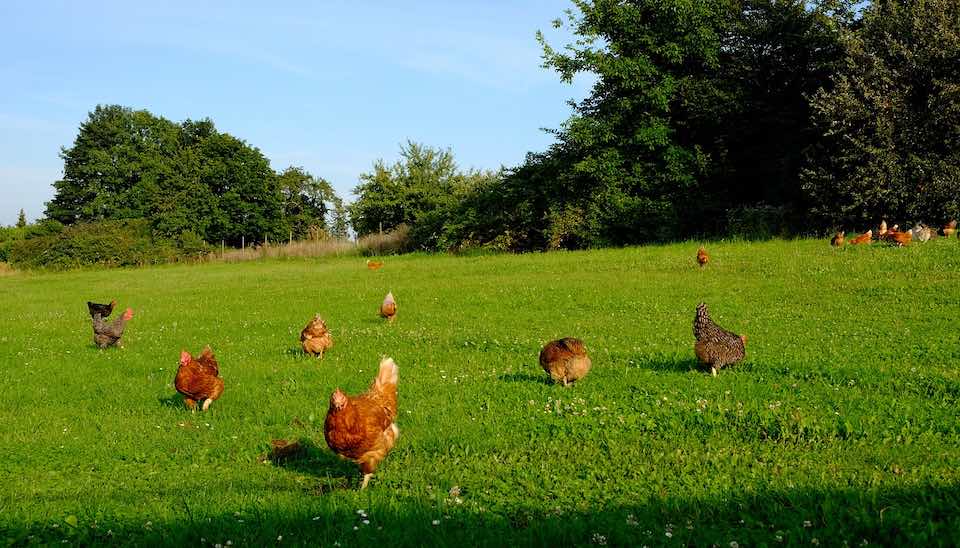The best roost for chickens
Where do chickens sleep?
Most chickens prefer to sleep on a roost rather than on the floor or in a nesting box. And trying to do the right thing, many backyard chicken keepers provide roosts in the form of broom handles or round bars. However, a perfectly round roost is actually one of the worst choices for chickens.
Why broomsticks are not a good roost for chickens
Broomsticks, dowels and other round roosts are not recommended for chickens. In fact, they can actually damage your chicken's feet.
Here are the reasons why broomsticks do not make good roosts for chickens:
1. They are too slippery
The harder chickens have to grip the perch, the more likely they are to suffer from foot issues.
2. They are too thin
Roosting chickens actually rest more on their keel bone than on their feet. The keel bone is not well protected and regular pressure leads to minute fractures and deformities that cause discomfort, health issues and reduced egg production.
3. They are too round
Unlike parrots, chickens have relatively flat feet. They should be able to curl their toes around the edge of their perch but the centre of their foot should be flat and their toes should never meet.
4. They are too uniform
Every chicken is different so a range of perch sizes is needed. There is also some evidence to suggest that small changes to their roosting spot on different sized roosts prevents foot issues.
The right roost for chickens
So what should chickens roost on? Fortunately there has been extensive scientific research into the ideal roost for chickens.
Studies conclude that:
Hens prefer higher roosts
Where options are available, hens will choose the highest perch. If there is not enough space more dominant hens will force others to lower roosting spots, often causing falls in the process. Therefore, best practice is to provide enough roosting space for all hens on the highest perch, even if this means multiple perches. However, lower perches are useful as steps to and from the higher roosting spots and hens use them during the day for activities such as sitting and preening.
Roosts shouldn't be higher than 1 m above the ground
Despite being able to fly, chickens tend to land heavily. If they have to jump too far from their perch to the ground, the heavy landings can cause bumblefoot and bone damage, including keel bone fractures. Additionally, falls are common when hens are scuttling for roosting position in the evening. Therefore, roosts should be close enough to the ground that unexpected falls won’t cause injury.
Roosts should be 30-50 cm apart
Because falls and collisions with roosts are some of the main causes of keel bone damage, roosts should be close enough together for hens to jump easily between them but far enough apart that a falling hen is unlikely to hit one the way down.
Provide 14 cm of space per hen
A minimum of 14 cm of perch space (width) per average-sized hen is needed for comfort and well-being. Hens without enough space may choose not to roost, and lack of space may also lead to issues like bullying and feather pecking. More or less space may be needed for roosters, different breeds etc.
Choose roosts that are at least 5 cm in diametre
Because hens have evolved to rest with relatively flat feet, with just the toes curling over the edges of the roost, they invariably prefer wider perches. They spend more time on perches of over 4.5 cm in diameter and balance movements decrease with perch diameter, suggesting hens get better rest when roosting on wider perches. Most studies used 5 cm as their maximum perch diameter, but larger breeds and roosters may require even wider roosts.
Roosts can be round or square
Although hens roost relatively flat footed, they do like to be able to curl their toes around the edge of the perch at the front and back. This means that chickens prefer round or square/rectangular perches when compared to a flat perch such as a board. Studies have shown that square perches better distribute weight on the keel bone in comparison with round perches. However, oval or round perches may be better for chickens’ feet. If choosing a square or rectangular perch, it is good to round the edges slightly.
Wood is best
Although easier to clean, metal and plastic perches contribute to bumblefoot and keel bone issues. In commercial industries, they have trialled perches with a soft covering that reduces foot pad and keel bone pressure, such as rubber or foam. However, although this covering reduces pressure it does not reduce either bumblefoot or keel bone damage when compared with a hardwood perch.
Roosts should suit your bird
Because chickens all have slightly different feet, it is good practice to provide a range of perch widths. This is particularly important in mixed-breed flocks, flocks of mixed ages and where roosters are kept alongside chickens. A range of perch diameters and shapes at the same height is ideal, and may be achieved with natural wood perches, such as tree branches, or a range of bought wood.




